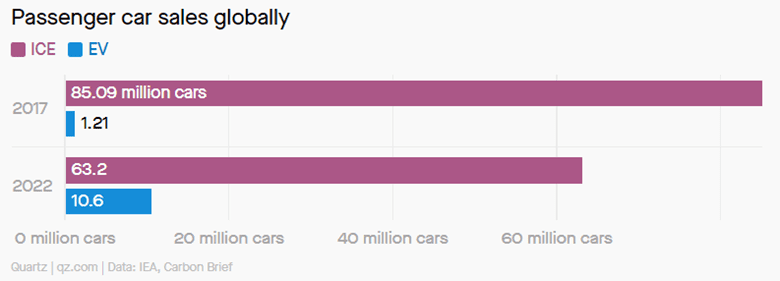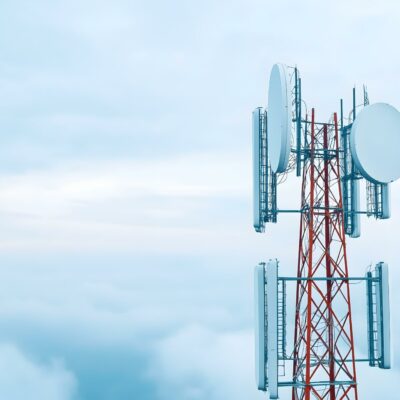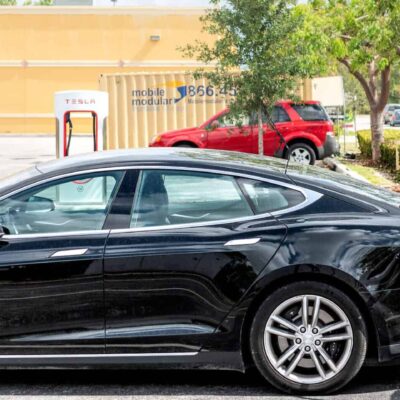As more automotive companies transition to focus on future-forward vehicle technology, the auto industry is shifting away from traditional manufacturing and partnership agreements to something new entirely. By 2035, it is estimated that more than 83.3 million EVs will be hitting the roads in the United States and Canada. This stark shift away from ICE vehicles has been a long time coming; in 2017, one in every 70 cars sold was an EV, while today, one in every seven cars sold is electric.

As competition in the industry heats up with major players and new entrants alike fighting for market share, we wanted to know: what is to come in automotive litigation?
An Automotive Expert’s Insight
To better understand what types of conflicts we should expect to see throughout 2023 and beyond, we asked WIT IP Panel Member and highly regarded automotive industry expert, Julie Wurmlinger, for her thoughts on the industry’s legal landscape. Ms. Wurmlinger has more than 30 years of industry experience and actively consults clients on electronics, IT, automotive engineering, and more. Let’s take a look at what she has to say about the state of the market and potential future conflicts.
WIT: As competition in the auto industry ramps up, where do you see the potential for disputes regarding the evolution and electrification of the automotive space?
Wurmlinger: The electrification of the mobility sector is resulting in challenges for the supply chain, intellectual property, mergers, and more. There are many new entrants in the supply chain that are also prompting the emergence of new industry partnerships; for example, automakers are now partnering with tech companies, creating a non-traditional flow of shared parts. More specifically, new entrants and start-ups can create new tech in the market without proper knowledge and handling of prior patents.
While the landscape surrounding partnerships seems to be evolving, the number of mergers and acquisitions in the industry continues to rise as start-up funding begins to slow. Previously, the trend indicated a steady increase from the first quarter of 2021 through the first quarter of 2022. Currently, around 60% of the focus appears to be on acquisitions rather than fundraising through investors. Some startups are using mergers to inorganically grow, while many major players’ acquisitions are focused on acquiring talent as opposed to technology.
The legal ramifications associated with these activities are bound to become litigious, with questions around trade secret ownership, patent ownership, and the royalties/incentives creating conflict, especially given the complicated nature of multiple mergers and acquisitions that can sometimes occur in one technology space. I also believe that talent acquisitions can become complicated by patent ownership (personal vs. corporate) and non-compete agreements, further adding to the legal concerns in the courts over IP, mass tech layoffs, and trade secrets.
WIT: When it comes to connected vehicles, what areas do you believe will offer the most likelihood of disputes?
Wurmlinger: In the connected vehicles space, I predict that potential conflicts will arise surrounding all things data- data ownership, access, sharing, and protection. The distinction between personal data vs shared data needs to be made while also ensuring that proper data security processes are in place in order to ensure vehicle cyber-security.
This can become even more complicated when coordinating data sources between OEMs and suppliers, creating the opportunity for data breaches, questions over data ownership, and the legal ramifications that can arise, necessitating risk management. More broadly, cybersecurity will be a concern, but with the element of data ownership as a complicating factor particularly in situations where a perceived value increase has resulted from the data provider claiming ownership. To prevent this, players will begin to (if they haven’t already) require a data contract up-front between the parties involved, making the development and use protocols available to delineate ownership boundaries.
WIT: With innovation in autonomous technology increasing, where do we see the risks for litigation surrounding autonomous vehicles?
Wurmlinger: A consideration for potential litigation in this space looks at one of the biggest complications manufacturers are faced with when it comes to autonomous technology: the transference of the driving task from the vehicle to the driver back to the vehicle, and so forth. In the instance of a collision, it is important to be able to make the distinction over who is liable and properly evaluate claims of fault by either the driver or the vehicle, as there is a window of time where a driver needs to re-orient to driving the vehicle (somewhere between 8 seconds to 40 seconds).
To orient autonomous industry players for success and prevent potential litigation, United States regulators need to create specific guidelines surrounding the responsibilities during the gap between the vehicle and owner control. US regulations are still evolving to regulate AVs; in 2016, the Federal Automated Vehicles Policy was released with several updates over the years, but it is unclear if the policy covers this transference. Federal Motor Vehicle Safety Standard- like regulations have been updated by the National Highway Traffic Safety Administration to support AVs, but not enough to mitigate the risks associated with autonomous driving liability.
How Experts Can Help Mitigate Risk
When considering the complications above, let’s evaluate the essential role that experts play in preparing for complex litigation involving automotive technology.
Looking at intellectual property, it is evident that disputes regarding EV patents, shared mobility components, and startup suppliers will likely ramp up as auto industry players attempt to stake their claim in the market. As more and more automakers enter the arena and industry suppliers work across verticals, protecting innovation is essential. Experts in these conflicts can step in to evaluate patent pools, complete damages analyses, and examine EV software to mitigate risk and form a strong litigation strategy.
Mergers, acquisitions, and impending partnerships, especially those involving start-ups, will also be an area to watch as companies look to ignite growth and acquire high-quality tech talent. M&As in this sector are steadily increasing, meaning the risk of litigation regarding these activities will likely increase as well. Engaging with an automotive industry expert can help those involved in M&A transactions understand the contracts, finances, and due diligence associated with acquisitions.
Lastly, conflicts surrounding connected vehicle technology are sure to ramp up as 5G technology improves, 6G technology prepares for launch, and manufacturers look to make their vehicles “stand out from the crowd” in terms of technology offerings. Collaborating with a wireless communications expert can help you mitigate the risks associated with EV software, wireless networks, and connectivity.
Want to learn more about what’s to come in the automotive industry and electric vehicles market? Reach out to WIT to schedule a partner briefing or to connect with the best experts. Our electric vehicles expert team was created to address what we expect to be the key areas of litigation in the move to electric and autonomous vehicles.




